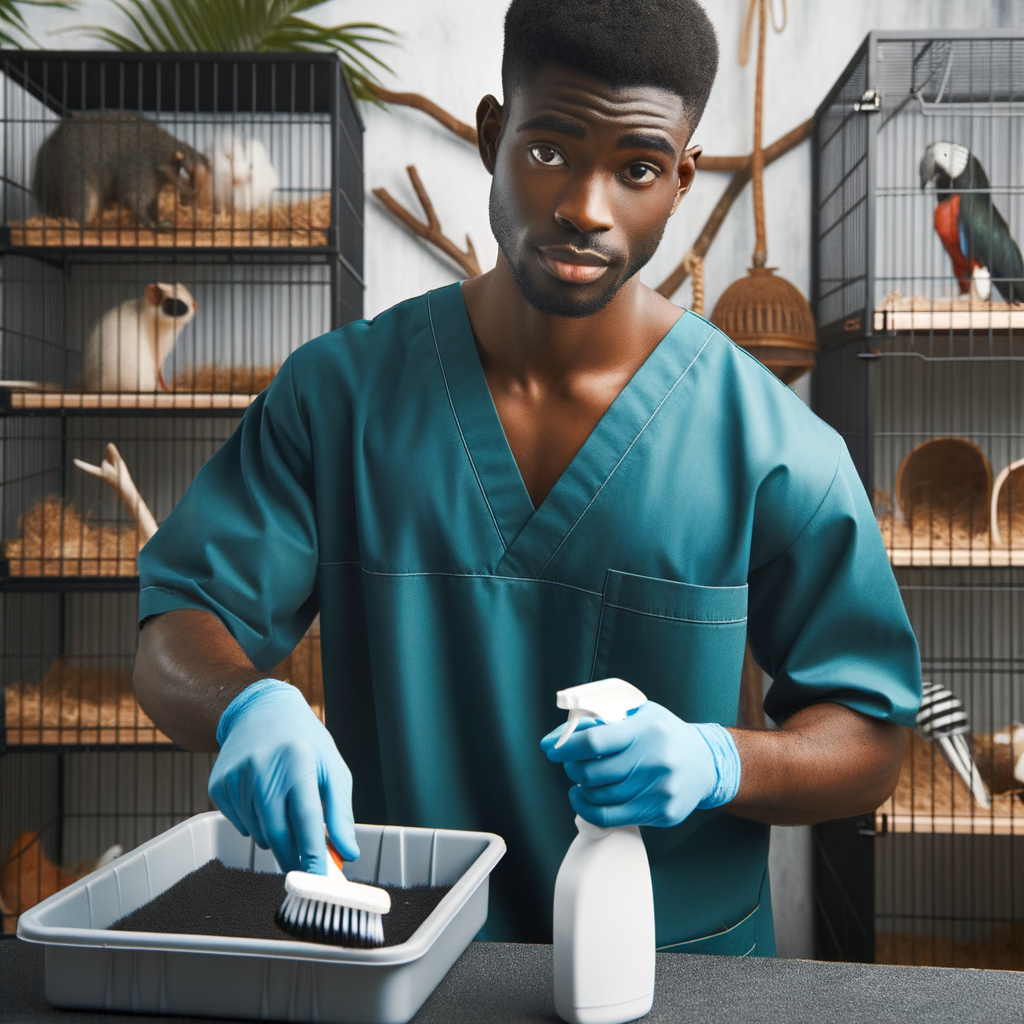
Introduction to Exotic Pet Care
Welcome to the fascinating world of exotic pets! These unique creatures require special care and attention to thrive. In this guide, we’ll explore the unique needs of exotic pets and the importance of maintaining a clean habitat for their health. Let’s dive in!
- Understanding the Unique Needs of Exotic Pets
- The Importance of Maintaining a Clean Habitat for Pet Health
Exotic pets, unlike common pets like dogs and cats, have unique needs that stem from their natural habitats. For instance, a snake may need a heat lamp to mimic the warm environment it’s used to, while a parrot might require a diet rich in fruits and seeds. Understanding these needs is crucial to provide the best care for your exotic pet.
Research is your best friend when it comes to exotic pet care. Learn as much as you can about your pet’s natural habitat, diet, and behavior. This knowledge will help you create a comfortable environment for your pet and ensure it stays healthy and happy.
Maintaining a clean habitat is not just about aesthetics; it’s a crucial aspect of your pet’s health. A dirty habitat can lead to the growth of harmful bacteria and parasites, which can cause various health issues in your pet.
Regular cleaning and sanitation of your pet’s habitat can prevent these issues. It’s also important to monitor your pet’s behavior for any signs of illness, as early detection can make a significant difference in treatment.
In the following sections, we’ll delve deeper into exotic pet habitat cleaning tips, pet sanitation guidelines, and exotic animal hygiene. Stay tuned to learn more about how to provide the best care for your exotic pet.
Exotic Pet Habitat Cleaning Tips
Keeping your exotic pet’s habitat clean is not just about aesthetics; it’s about their health and happiness. Here are some safe pet habitat cleaning tips to ensure your pet’s environment is as clean and comfortable as possible.
Safe Pet Habitat Cleaning
When it comes to cleaning your pet’s habitat, safety should be your top priority. Here are some key points to consider:
- Choosing the right cleaning products: Not all cleaning products are safe for your exotic pet. Some can be toxic or irritating to their skin, eyes, or respiratory system. Look for pet-safe, non-toxic cleaning products. Avoid products with strong fragrances, as these can also be irritating to your pet.
- Frequency of cleaning: Regular cleaning is essential to prevent the build-up of bacteria and waste. The frequency of cleaning will depend on the type of pet and its habitat. As a general rule, spot clean daily and do a thorough clean once a week. Always check with your vet or a pet care professional for specific advice.
- Spot cleaning vs deep cleaning: Spot cleaning involves removing visible waste or soiled areas daily. This helps keep the habitat clean between deep cleanings. Deep cleaning involves completely emptying the habitat, cleaning all surfaces, and replacing substrate and bedding. This should be done weekly or as advised by a pet care professional.
Remember, a clean habitat is a happy and healthy habitat for your exotic pet. By following these tips, you can ensure your pet’s environment is safe, clean, and comfortable.
Cleaning Exotic Pet Cages
Keeping your exotic pet’s cage clean is not only essential for their health but also for the overall hygiene of your home. Here, we will guide you through the process step-by-step and highlight some common mistakes to avoid.
- Step-by-step guide to cleaning cages
- Preparation: Gather all necessary cleaning supplies. This includes a scrub brush, pet-safe disinfectant, and gloves.
- Removal: Carefully remove your pet from the cage and place them in a safe, temporary habitat.
- Cleaning: Empty the cage of any toys, bedding, and food dishes. Scrub the cage thoroughly with the brush and disinfectant.
- Rinsing: Rinse the cage thoroughly to ensure no disinfectant residue remains.
- Drying: Allow the cage to dry completely before replacing the toys, bedding, and dishes.
- Return: Once the cage is dry and reassembled, carefully return your pet to their clean habitat.
- Common mistakes to avoid
- Using harsh chemicals: Always use pet-safe disinfectants to avoid harming your pet.
- Not rinsing thoroughly: Any disinfectant residue can be harmful to your pet. Make sure to rinse the cage thoroughly.
- Not drying the cage completely: A damp cage can promote the growth of mold and bacteria. Ensure the cage is completely dry before returning your pet.
- Rushing the process: Cleaning your pet’s cage is not a task to rush. Take your time to ensure a thorough cleaning.
Follow these steps to ensure a thorough cleaning of your exotic pet’s cage:
When cleaning your exotic pet’s cage, avoid these common mistakes:
By following these steps and avoiding common mistakes, you can provide a clean and safe environment for your exotic pet.
Pet Sanitation Guidelines
Keeping your exotic pet’s environment clean is not just about aesthetics; it’s also about health. Proper sanitation is a crucial part of pet care that can prevent the spread of diseases. Here, we will discuss some essential sanitation procedures for exotic pets.
Sanitation Procedures for Exotic Pets
Exotic pets often require special care and attention when it comes to sanitation. Here are three key steps to ensure a clean and safe environment for your pet:
- Proper Hand Hygiene
- Disinfecting Pet Accessories
- Managing Pet Waste
Before and after handling your pet, always wash your hands thoroughly. This simple act can prevent the spread of bacteria and parasites. Use warm water and soap, and scrub for at least 20 seconds. Don’t forget to dry your hands properly as well.
Regularly clean and disinfect your pet’s accessories, such as toys, feeding bowls, and cages. You can use a mild detergent or a pet-safe disinfectant. Remember to rinse thoroughly to remove any residual cleaning agents that could harm your pet.
Proper waste management is crucial in maintaining a clean habitat for your pet. Dispose of waste promptly and clean the area with a pet-safe disinfectant. For pets that use litter boxes, ensure you change the litter regularly.
Remember, a clean environment is a healthy environment for your pet. By following these sanitation guidelines, you can ensure that your exotic pet lives a long, happy, and healthy life.
Exotic Animal Hygiene
Hygiene is a critical aspect of exotic pet care. It’s not just about keeping your pet’s habitat clean; it’s also about ensuring your pet’s health and well-being. Let’s delve into the importance of hygiene for exotic pets and how it affects their health.
Exotic Pet Health and Hygiene
Exotic pets, like any other animals, require proper hygiene to stay healthy. This involves regular vet check-ups and maintaining cleanliness to prevent common health issues related to poor hygiene.
- Importance of regular vet check-ups
- Common health issues related to poor hygiene
Regular vet check-ups are essential for your exotic pet’s health. These check-ups help detect any potential health issues early, which can be crucial for exotic pets as they often hide signs of illness. A vet can also provide advice on proper hygiene and care specific to your pet’s species.
Poor hygiene can lead to various health issues in exotic pets. These can include skin infections, parasitic infestations, and respiratory problems. For instance, reptiles can develop mouth rot if their habitat is not cleaned regularly. Birds can suffer from feather plucking due to poor hygiene. Therefore, maintaining good hygiene is vital to prevent these health issues.
In conclusion, hygiene plays a significant role in the health of exotic pets. Regular vet check-ups and maintaining cleanliness can prevent common health issues and ensure your pet’s well-being. Remember, a clean pet is a happy and healthy pet!
Pet Habitat Maintenance
Maintaining your pet’s habitat is an essential part of pet care, especially when it comes to exotic pets. This section will provide you with a step-by-step guide on setting up and maintaining a comfortable and clean habitat for your exotic pet.
Exotic Pet Habitat Setup
Setting up an exotic pet habitat can be a challenging task. It requires careful planning and consideration to ensure the comfort and safety of your pet. Let’s break down the process into two main steps:
- Choosing the right habitat
- Setting up the habitat for comfort and cleanliness
Choosing the right habitat for your exotic pet is the first step towards ensuring their comfort and well-being. The habitat should be spacious enough for your pet to move around freely and engage in natural behaviors. It should also be appropriate for the specific needs of your pet’s species. For example, a reptile might need a habitat with a heat source, while a bird might need a cage with plenty of perches and toys.
Once you’ve chosen the right habitat, the next step is to set it up for comfort and cleanliness. This involves adding bedding or substrate, installing temperature and humidity controls if necessary, and arranging furniture or decorations to provide enrichment. Regular cleaning is also crucial to prevent the buildup of waste and bacteria. A clean habitat not only keeps your pet healthy but also makes them more comfortable and happy.
In conclusion, maintaining a clean and comfortable habitat is a crucial part of exotic pet care. It requires careful planning and regular upkeep, but the rewards of seeing your pet thrive in a well-maintained habitat are well worth the effort.
Conclusion: The Importance of Clean Habitats for Exotic Pets
In this article, we’ve explored the fascinating world of exotic pet care, focusing on the crucial role that clean habitats play in the health and happiness of these unique animals. Let’s recap our key takeaways and share some final thoughts on exotic pet care and hygiene.
- Recap of key takeaways
- Final thoughts on exotic pet care and hygiene
Firstly, we learned that exotic pets, unlike common pets like dogs and cats, have specific habitat requirements that need to be met for them to thrive. These requirements can range from temperature and humidity control to specific types of bedding and enclosure setups.
Secondly, we delved into various cleaning tips and sanitation guidelines that are essential for maintaining a clean habitat. We highlighted the importance of regular cleaning schedules, the use of pet-safe cleaning products, and the need for thorough disinfection to prevent the spread of diseases.
Lastly, we discussed the importance of personal hygiene when handling exotic pets. Regular hand washing and avoiding direct contact with pet waste can significantly reduce the risk of zoonotic diseases.
Exotic pet care can be a challenging but rewarding experience. The key to success lies in understanding the specific needs of your pet and providing a clean and suitable habitat that mimics their natural environment as closely as possible.
Remember, a clean habitat is not just about aesthetics; it’s about creating a safe and healthy environment for your exotic pet. Regular cleaning and maintenance, coupled with good personal hygiene practices, can go a long way in ensuring the well-being of your pet.
As the famous naturalist John Muir once said, “When one tugs at a single thing in nature, he finds it attached to the rest of the world.” This is especially true for exotic pets. By taking care of their habitats, we are not just caring for them but also contributing to the larger ecosystem.








